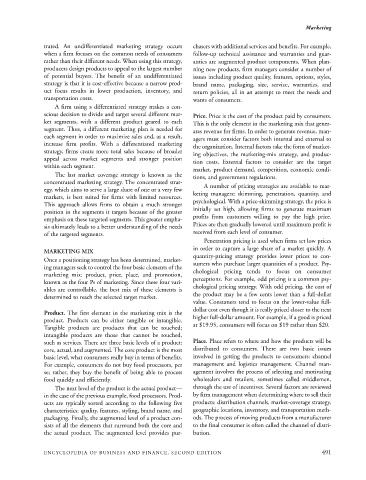Page 514 - Encyclopedia of Business and Finance
P. 514
eobf_M 7/5/06 3:15 PM Page 491
Marketing
trated. An undifferentiated marketing strategy occurs chasers with additional services and benefits. For example,
when a firm focuses on the common needs of consumers follow-up technical assistance and warranties and guar-
rather than their different needs. When using this strategy, anties are augmented product components. When plan-
producers design products to appeal to the largest number ning new products, firm managers consider a number of
of potential buyers. The benefit of an undifferentiated issues including product quality, features, options, styles,
strategy is that it is cost-effective because a narrow prod- brand name, packaging, size, service, warranties, and
uct focus results in lower production, inventory, and return policies, all in an attempt to meet the needs and
transportation costs. wants of consumers.
A firm using a differentiated strategy makes a con-
scious decision to divide and target several different mar- Price. Price is the cost of the product paid by consumers.
ket segments, with a different product geared to each This is the only element in the marketing mix that gener-
segment. Thus, a different marketing plan is needed for ates revenue for firms. In order to generate revenue, man-
each segment in order to maximize sales and, as a result,
agers must consider factors both internal and external to
increase firm profits. With a differentiated marketing the organization. Internal factors take the form of market-
strategy, firms create more total sales because of broader
ing objectives, the marketing-mix strategy, and produc-
appeal across market segments and stronger position
tion costs. External factors to consider are the target
within each segment.
market, product demand, competition, economic condi-
The last market coverage strategy is known as the
tions, and government regulations.
concentrated marketing strategy. The concentrated strat-
A number of pricing strategies are available to mar-
egy, which aims to serve a large share of one or a very few keting managers: skimming, penetration, quantity, and
markets, is best suited for firms with limited resources.
psychological. With a price-skimming strategy, the price is
This approach allows firms to obtain a much stronger
position in the segments it targets because of the greater initially set high, allowing firms to generate maximum
profits from customers willing to pay the high price.
emphasis on these targeted segments. This greater empha-
Prices are then gradually lowered until maximum profit is
sis ultimately leads to a better understanding of the needs
of the targeted segments. received from each level of consumer.
Penetration pricing is used when firms set low prices
in order to capture a large share of a market quickly. A
MARKETING MIX
quantity-pricing strategy provides lower prices to con-
Once a positioning strategy has been determined, market-
sumers who purchase larger quantities of a product. Psy-
ing managers seek to control the four basic elements of the chological pricing tends to focus on consumer
marketing mix: product, price, place, and promotion,
perceptions. For example, odd pricing is a common psy-
known as the four Ps of marketing. Since these four vari-
ables are controllable, the best mix of these elements is chological pricing strategy. With odd pricing, the cost of
determined to reach the selected target market. the product may be a few cents lower than a full-dollar
value. Consumers tend to focus on the lower-value full-
dollar cost even though it is really priced closer to the next
Product. The first element in the marketing mix is the
product. Products can be either tangible or intangible. higher full-dollar amount. For example, if a good is priced
Tangible products are products that can be touched; at $19.95, consumers will focus on $19 rather than $20.
intangible products are those that cannot be touched,
such as services. There are three basic levels of a product: Place. Place refers to where and how the products will be
core, actual, and augmented. The core product is the most distributed to consumers. There are two basic issues
basic level, what consumers really buy in terms of benefits. involved in getting the products to consumers: channel
For example, consumers do not buy food processors, per management and logistics management. Channel man-
se; rather, they buy the benefit of being able to process agement involves the process of selecting and motivating
food quickly and efficiently. wholesalers and retailers, sometimes called middlemen,
The next level of the product is the actual product— through the use of incentives. Several factors are reviewed
in the case of the previous example, food processors. Prod- by firm management when determining where to sell their
ucts are typically sorted according to the following five products: distribution channels, market-coverage strategy,
characteristics: quality, features, styling, brand name, and geographic locations, inventory, and transportation meth-
packaging. Finally, the augmented level of a product con- ods. The process of moving products from a manufacturer
sists of all the elements that surround both the core and to the final consumer is often called the channel of distri-
the actual product. The augmented level provides pur- bution.
ENCYCLOPEDIA OF BUSINESS AND FINANCE, SECOND EDITION 491

